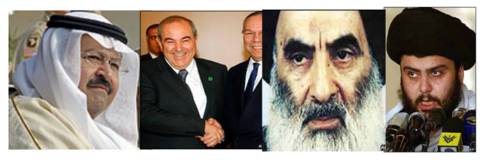
Can you identify these men?
If you want to understand the present and near future for Iraq, you need to.
On Friday, a Kerry supporter accused President Bush of letting terrorists get away, by agreeing to the cease-fire in Najaf today. Such an opinion is extremely ill-informed, but unfortunately is also not uncommon. Many people do not realize the meaning of the handover of Sovereignty, now nearly two month sold, nor the sort of developing identities of the groups which will direct and lead Iraq to its future. More directly, far too many people do not understand the reasons why the cease-fire in Najaf can mean a major step towards stability and success for Iraq and its people.
I begin with the fellow on the far right, Muqtada al Sadr. A BBC report describes al Sadr brifley, but cryptically:
"At times he has called for a national rebellion against foreign troops and sent out his militiamen to confront the "invaders" and Iraqi police. At others he has appeared more compromising, seeking for himself a political role within the new Iraq.
"He is thought to be about 30 years old - a youthful leader in a society which considers age and experience essential to religious authority.
"Moqtada Sadr mixes Iraqi nationalism and Shia radicalism, making him a figurehead for many of Iraq's poor Shia Muslims. His detractors see him as an inexperienced and impatient radical who aims to dominate Iraq's most revered Shia institutions by force."
All of these statements, actually, are on the mark. I'll come back to these as I introduce the other key figures.
The next fellow from the right is the most revered Ayatollah Ali Sistani. Yes, he looks and sounds, to Americans at least, like another Khomeini, but there is a lot more to this man, and the dynamic he represents, than is apparent at first. I will come back to cover this more, but for right now, it's worth mentioning, that this man was recuperating in London from heart trouble, and he negotiated his way to Iraq, then with the interim government, then with al Sadr's organization to resolve the stalemate in Najaf as peracefully as possible.
The second picture from the left is Prime Minister Iyad Allawi. Allawi has been the most visible member of the new Iraqi government, and in the Najaf issue, it's worth noting that Allawi, on the one hand, agreed to Sistani's proposal to make Najaf and Kufa "weapons-free' cities. But on the other hand, Allwai personally reinstated the death penalty, and warned that martial law would be considered if the violence continued. This combination of force and reason illustrates the balance Allawi hopes to maintain in his work to create a functional coalition of Iraqis.
The far left photo is a man almost unknown to Americans, and yet he may be the most significant of all. President Ghazi Yawer of Iraq represents the traditional Arab authority, and performs his work without much attention or controversy.
This brings us to the events in Najaf.
For the past 22 days, Iraqi, Coalition, and rebel forces have been killing each other in the town of Najaf. I put it that way, because the resolution proposed needs to be seen against that backdrop.
The Ayatollah Sistani was recovering in London from medical treatment, and he took it upon himself to travel to Iraq, and to meet face to face, first with Allawi, then with al Sadr. The result bloomed this morning, when thousands of Shiite pilgrims entered the shrine of the Imam Ali Mosque, where al Sadr and his buddies had been holed up. Mixing with the pilgrims, al Sadr's men were able to simply walk away from the mosque without getting killed or arrested. This was an optimal solution, for the following reasons:
- For al Sadr, he avoided a humiliating defeat and the loss of his power base in Iraq. Muqtada is popular with the poorest Shiites, so it was necessary to accomodate him to some degree. Also, this solution avoided allowing al Sadr to become a martyr, and taught him a lesson that cooperation can be preferable to direct opposition;
- For Sistani, a peaceful solution avoided the deaths of Muslims at the hands of other Muslims. It also taught al Sadr his place in the hierarchy of Iraqi Islam, as Sistani proved his ability to accomplish more in one meeting, than al Sadr has with more than a dozen threats and provocations;
- For Prime Minister Allawi, two cities which have been hot spots are now pledged to non-violence, and regular Iraqis have reason to believe there is a foundation of cooperation on which to build;
- For President Yawer (and President George W. Bush), it means that Iraqis were able to work out their issues with other Iraqis, with no foreign involvement. The new Iraqi government has gained some stature, and can now work on other issues put on hold.
Iraq is by no means done with the long road to its new identity. But the succesful arrangement, if it holds, could represent some of the first steps taken on its own by the child who must grow up so quickly.
Presidents Yawer and Bush could have good reason to be proud of this accomplishment, even if most people do not realize the significance.
